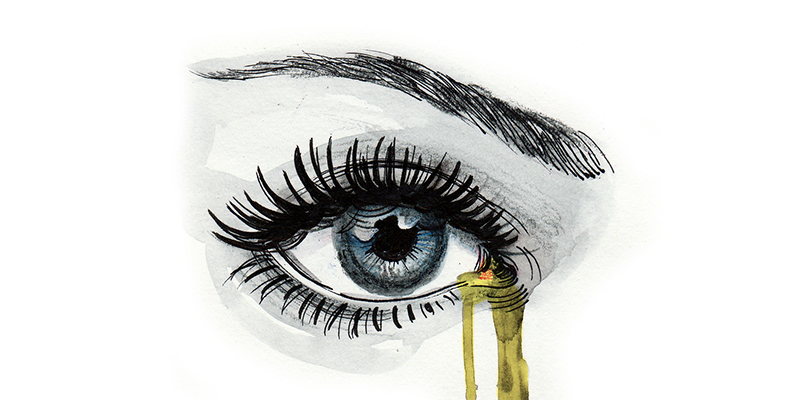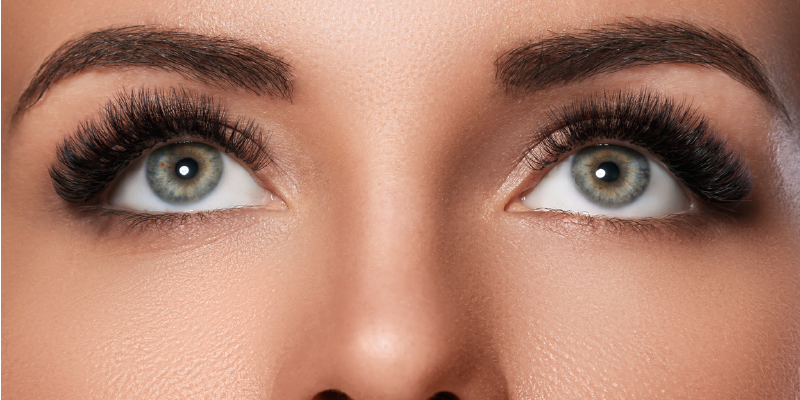Seborrheic Dermatitis (SD) is a common condition that affects many people. Typically the skin of the scalp becomes inflamed and flaky, though it can occur in other oily areas of the skin, as well, including the eyelids.
Itchy, irritated eyes are no fun!
SD is lumped into the general category of eyelid dermatitis, which can include other causes such as:
- Contact dermatitis (allergic and irritant)
- Atopic dermatitis
- Rosacea
They’re a group of inflammatory skin disorders that localize to the eyelids and can resemble eczema.
Risk Factors for Seborrheic Dermatitis Around the Eyes

The skin around the eyes is very thin and delicate, so eyes are super sensitive to any irritation.
There are some risk factors that increase the likelihood of developing this condition:
- Age: Infants are especially susceptible to seborrheic dermatitis, called cradle cap
- Certain Medications: Neomycin or beta-blockers can be triggers
- Neurologic and Psychiatric Conditions: Parkinson’s disease and depression
- Weakened Immune System: Organ transplant patients and people with HIV/AIDS, alcoholic pancreatitis, and some cancers
- Recovery Period: During recovery from stressful medical conditions like a heart attack
- Hormones
- Nutrition
- General Physical Condition
- Stress
While doctors aren’t sure exactly what causes SD, they believe it may be related to
- A yeast (Malassezia) that is in the oily secretion of the skin
- An irregular response of the immune system
Symptoms of Seborrheic Dermatitis of the Eyelids

SD can cause a series of symptoms of the eye called blepharitis. It is an inflammation of the eyelids in which they become red, irritated, and itchy and dandruff-like scales form on the eyelashes.
While uncomfortable, it isn’t usually contagious and doesn’t tend to cause any permanent damage to eyesight.
Blepharitis can be classified into two types, dependent upon which area of the eyelid is affected:
- Anterior Blepharitis is found along the outside front edge of the eyelid, where the eyelashes attach.
- Posterior Blepharitis takes hold along the inner edge of the eyelid where it touches the eyeball.
Symptoms may include:
- Scales
- Matted, hard crusts around the lashes
- Crusting that makes opening the eyes in the morning difficult
- Chronic redness at the edges of the eyelids
- Dilated blood vessels
- Loss of eyelashes
- Sties
Sufferers might experience a gritty or burning sensation in the eyes, excessive tearing, itching, red and swollen eyelids, dry eyes, or crusting of the eyelids.
Often, people with blepharitis think they have “dry eyes,” but lubricating drops don’t do much good in helping them to feel better.
Some people may just experience minor irritation, while others may experience more severe problems like blurred vision, missing or misdirected eyelashes, or inflammation in other areas of the eye like the cornea.
The signs and symptoms might be more severe when experiencing stress, and they tend to flare up in cold, dry seasons.
Touching or rubbing the eye can lead to secondary infections.
What to Do for Seborrheic Dermatitis and Blepharitis

For most people, blepharitis doesn’t typically go away completely. Symptoms can come and go over the course of time.
Treatment is usually ongoing and sometimes frustrating. Should you develop it, expect to maintain therapy routines for a long time to keep blepharitis at bay.
While it may feel like there is no end in sight, there are things that you can do to help relieve symptoms.
In most cases, good hygiene will help to control blepharitis. The key to treating it is to keep the lids clean and free of crusts.
When SD causes scalp dandruff, a dandruff shampoo for the hair is recommended. If a bacterial infection accompanies blepharitis, antibiotics or other medications may help.
When an underlying problem like acne rosacea exists, that should be treated, as well.
To provide relief and clear up problem eyelids, use warm compresses to soak the area to loosen debris, then scrub gently using a product designed to clean eyelids.
A Natural Solution
Cliradex is doctors’ choice for gentle cleaning without harmful chemicals. It’s formulated from the key, beneficial components of tea tree oil, while being mild and non-irritating, causing no damage to the skin and supporting healthy eyelids and lashes.
This all-natural solution effectively cleans eyelids, lashes, and the face without any harmful chemicals or preservatives.
Cliradex Towelettes are formulated to clean deeply to alleviate moderate-to-severe symptoms of blepharitis.
Cliradex Light is ideal for those times between flare-ups: for daily hygiene, preventative care, and mild symptom relief.
Their convenient formulations penetrate deep into the skin, with a natural, soothing facial cleansing agent.
Since blepharitis from SD can be persistent, practice ongoing skin and eyelid hygiene to prevent recurrences. Washing hair, scalp, and eyebrows with antibacterial shampoo could also help to control any flare-ups.





